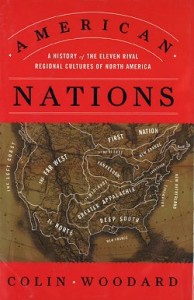Why We Can’t Get Along – Regional Rivals
February 18, 2013If some American cities are known for their sports rivalries, regions across the continent are also defined and divided by their political and cultural rivalries. This is the thesis of…
 If some American cities are known for their sports rivalries, regions across the continent are also defined and divided by their political and cultural rivalries.
If some American cities are known for their sports rivalries, regions across the continent are also defined and divided by their political and cultural rivalries.
This is the thesis of another book that turned up in my search for “rivalries” in the library catalog – American Nations: A History of the Eleven Rival Regional Cultures of North America by Colin Woodard (New York: Viking, 2011). Woodard starts from early European exploration of North America and shows that, because of the way regional cultures developed over time, “the United States is a federation comprised of the whole or part of eleven regional nations, some of which truly do not see eye to eye with one another.”
He goes on to say: “Few have shown any indication that they are melting into some sort of unified American culture. On the contrary, since 1960 the fault lines between these nations have been growing wider, fueling culture wars, constitutional struggles, and ever more frequent pleas for unity.” The trouble with trying to achieve unity, however, is that “Each of our founding cultures had its own set of cherished principles, and they often contradicted one another.”
By tracing the history of each region, Woodard is able to explain their origins, defining characteristics and territories. It’s a long journey from 1590 to 2010, when the book ends, but it finally turns out that in the present day, these regions have separated out into political blocs: Yankeedom, New Netherland and the Left Coast on one side (figuratively speaking) and the Deep South, Greater Appalachia and the Far West (plains & mountain states) on the other. Somewhere in between are the Midlands, Tidewater and El Norte.
So here is the answer to the question: Why are red states red and blue states blue? And can they come together? If you believe Woodard, probably not. They can coexist, but our federal system is one of the few things that ties them together; they have no natural cohesion based on beliefs or culture.
As we ponder rivalry on this Presidents’ Day, we have recently come through an election that brought out this most fundamental and longstanding of American rivalries. To be continued?
In February and March, Indiana Humanities is exploring the topic of “rivalry,” as part of its Spirit of Competition theme. This post was written by Nancy Conner, director of grants and coordinator of Novel Conversations.


